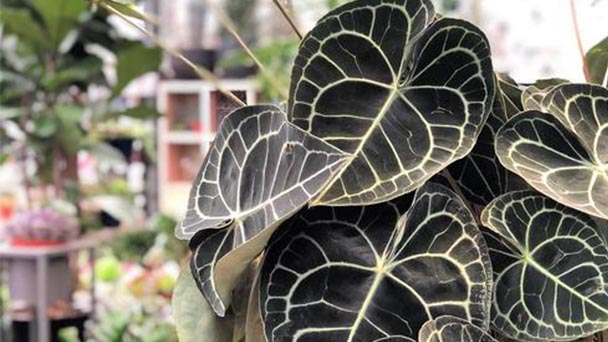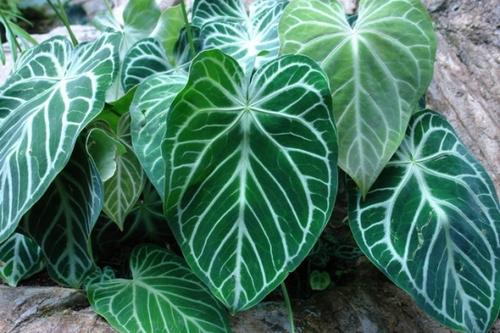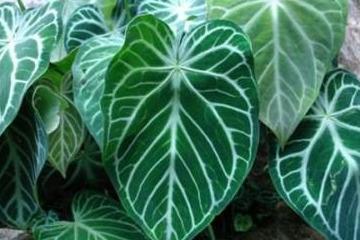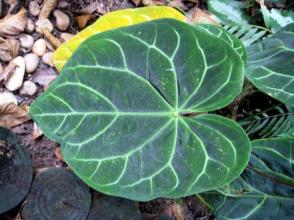Anthurium Crystallinum Profile: Info, Care & Propagation Guide
Written by Maggie
Dec 06 2021

Anthurium Crystallinum has oval-shaped leaves, fresh and elegant leaves, and high ornamental value. It is a good plant to grow indoors. If you want your garden or indoor room to look a bit more exotic, then consider planting anthurium crystallinum! Even though this is a plant native to tropical surroundings, with a little bit of proper care, Anthurium Crystallinum can grow beautifully in your home garden, living room, or kitchen. The following will introduce the details of Anthurium Crystallinum, how to grow and care for Anthurium Crystallinum and how to propagate Anthurium Crystallinum.
Anthurium Crystallinum Picture

Anthurium Crystallinum Basic Info
| Name | Anthurium crystallinum |
| Genus | Anthurium |
| Mature height | 30-50 cm (35 in) Tall |
| Growth rate | Fast |
| Light exposure | Indirect, Bright |
| Soil | Well-drained |
| Soil pH | 6.0-7.0 |
| Minimum Temperature | 16 °C (61 °F) |
| Watering | 2 times per week |
| Diseases | Fungus |
| Pests | Insects, mites |
Anthurium Crystallinum Characteristics
Anthurium Crystallinum is a perennial evergreen flower with a plant height of 30~50cm and a short stem. Leaf-blade is leathery, ovum elliptic to oblong-lanceolate, entire margin, stalk short. Flame bracts are broadly ovoid, long ca. The locum is deep red, waxy, lustrous. Cultivated varieties include pink, red, yellow, green, red Anthurium Crystallinum, etc. There are about 200 species of plants in the same genus, about 20 species of ornamental value, and a large number of hybrid species.
Anthurium Crystallinum Distribution & Habits
Anthurium Crystallinum is native to the rain forests of tropical America. Anthurium Crystallinum loves warm, moist and semi-cloudy environments. The optimum temperature is 20~25°C in winter, not less than 16°C. anthurium crystallinum requires higher air humidity, the soil should be fertile and loose, drainage is good. Artificial pollination must be carried out to propagation or crossbreeding.

How to Grow & Care for Anthurium Crystallinum
Anthurium Crystallinum Soil Care
Growing Anthurium Crystallinum needs to choose loose, breathable soil with good water retention. You can choose to mix with 3 parts of river sand, 3 parts of peat moss and 4 parts of fine wood chips to make it suitable for the growth of Anthurium Crystallinum, which can avoid water accumulation and make its roots grow better.
Anthurium Crystallinum Light Requirements
Light care is very important when growing Anthurium Crystallinum. Too little or too much light will not affect the final growth of Anthurium Crystallinum. Too little light will make the plant not vigorous, while too much light will sunburn the leaves and the leaves will turn colors. On sunny days, 75 percent of the sun should be blocked by a moveable overshadow net. There is no need for shading in the morning and evening. The demand of Anthurium crystallinum for light is also different at different times, and the requirement for light is relatively low when it blossoms. It can be shaded to prevent the flowers from becoming discolored when the light is too strong.
Anthurium Crystallinum Watering
Anthurium Crystallinum's drought tolerance requires that it be nurtured with plenty of water. When it rains, the Anthurium Crystallinum can be placed outside. Be sure to maintain a relatively high air humidity when growing Anthurium Crystallinum, especially in the summer when the temperature is particularly high. Water in winter should be done at higher temperatures to prevent Anthurium Crystallinum frostbite. Generally, it can be watered for 2 to 3 days once; Watering Anthurium Crystallinum can be 2 days a time in summer. If the temperature is high, you can water more; 5 to 7 days water Anthurium Crystallinum once in autumn.
Anthurium Crystallinum Temperature Care
You can grow Anthurium Crystallinum in ambient temperatures ranging from 65°F to 75°F (18 to 24°C). The temperature should be kept below 30℃. In summer, water spraying or atomization can be carried out to improve the humidity in the air to avoid damage caused by high temperatures. If the indoor temperature is lower than 16℃ in winter, the temperature should be raised to avoid Anthurium Crystallinum freezing injury and protect the safety of the winter.
Anthurium Crystallinum Humidity Care
This plant is a sucker for excessive air humidity. Anthurium Crystallinum requires relatively high humidity in the air. Too little humidity causes Anthurium Crystallinum plants to grow old and have smaller leaves and flowers; Too much humidity will leave the plant vulnerable to fungal invasion. When the temperature is 20℃ to 28℃, the humidity should be 60% to 70%; When the temperature reaches above 28℃, the humidity should be between 70% and 80%. Especially in the high-temperature season, the relative humidity of the air in the greenhouse can be increased by a spraying system and atomizing system to create a high humidity growth environment. But in winter, even if the greenhouse temperature is higher, it should not be too wet, because if it is too wet, Anthurium crystallinum plant leaves will reduce its cold resistance, easy to make it frostbite, not conducive to safe winter. The high humidity between 70% to 80% works ideally to grow and care for Anthurium Crystallinum. Another Anthurium Crystallinum care hack is to grow in your loo furnished you have a well-lit window or grow lights in there.
Anthurium Crystallinum Fertilizer Care
Like any houseplant, our Anthurium Crystallinum has its diet desires for the most beneficial growth. But Anthurium Crystallinum care desires little as soon as the potting combine is properly enriched with natural content. You may also on the other hand use well-balanced fertilizer to enhance the growth. Since the leaves of Anthurium Crystallinum have a waxy coating that doesn't absorb fertilizer well, applying fertilizer to the roots works much better. Be sure to spray the leaves with water two hours after fertilization to wash off any remaining fertilizer to keep the leaves clean and avoid algae growth.
Anthurium Crystallinum Pruning Care
Pruning Anthurium Crystallinum should be carried out once at the mature stage. Cut withered branch, branch with disease and insect, too thin branch and too close branch. There is generally no need to prune Anthurium Crystallinum during the growing stage, except to shorten the branches that protrude from the crown when the tree is unbalanced.Anthurium Crystallinum Growth Rate
Anthurium Crystallinum is an actual gradual grower. It offers one new leaf in about three to four weeks. The leaf blades are medium-sided every so often developing to a most of 30 cm (12 inches) in the domestic environment. They’re pretty compact and are appropriate for indoor growing. Patio in summers and greenhouse in winters is the best way for those who stay in the less warm zones.
Anthurium Crystallinum care doesn't require a good deal of pruning – simply periodical deadheading of dry leaves and inflorescences is exact enough.
Anthurium Crystallinum Potting
Potting is a pretty easy procedure when you grow Anthurium Crystallinum. Layer a small pot with natural rubble, vicinity the plant in the pot, and pour in the chunky combination round the roots.
Five months after planting, Anthurium Crystallinum needs to be transferred into a new 18cm pot soil. Do not water the pot for several days before you change the pot, and then change Anthurium Crystallinum into new pot after the potting soil is half dry. Because the potting soil is too wet, the viscosity between the pot wall and the soil is too large, which is not conducive to the whole soil bulb emergence, and too dry will affect the growth of the Anthurium Crystallinum.
Anthurium Crystallinum Disease & Pest Control
The diseases of Anthurium Crystallinum mainly include bacterial fusarium wilt, root rot and leaf spot disease. Among them, bacterial fusarium wilt is destructive and is the key object of prevention and control. The disease usually begins on leaves and flowers. The symptoms of the disease are brown spots in the middle and yellow spots on the periphery. From normal to infected tissues, water stains can be seen. Fusarium wilt spreads and causes harm at a fast speed, and the target of infection is mainly leaves. When the infection degree increases and becomes systematic invasion, the whole plant will be killed. There are currently no effective drugs to treat bacterial fusarium wilt. Therefore, once an outbreak occurs, firm measures must be taken to destroy the affected plant and nearby plants completely, and extremely strict quarantine measures must be taken for the remaining plants.The root rot and leaf spot disease of Anthurium Crystallinum are mostly fungal infections, and fungicides can be used to control the disease. Combined with fine water and fertilizer management, the infected plants can generally recover robust growth.

How to Propagate Anthurium Crystallinum
The main methods of Anthurium Crystallinum propagation are dividing, cutting, seed and tissue propagation.
Anthurium Crystallinum Propagation from Division
Anthurium Crystallinum propagation by dividing is usually carried out in spring. First, cut all of the lateral bud of stock plan and and put it in shadow after the wound is dried. Plant the plant into wet soil with rich organic matter and put it in the shade. Spray water on the surface and the Anthurium Crystallinum plant will germinate around 1 ~ 2 weeks.
Anthurium Crystallinum Propagation from Cutting
Cutting is one of the propagation methods of Anthurium Crystallinum. Select plant branches with 1 to 2 stem nodes at the growing stage, cut into smooth oblique shape, and directly inserted into the wet water moss. The temperature should be controlled at about 20 ~ 25℃. After germination, then transplant the Anthurium Crystallinum plant.
Anthurium Crystallinum Propagation from Seeds
When propagating Anthurium Crystallinum from seed, you can select plump and large seeds in the mature season, control the proper temperature for germination at about 15 ~ 28℃, bury them directly in the prepared nutrient soil, spray water every day to moisturize, but do not water. About 20 ~ 25 days it will germinate, and about 3 ~ 4 years after the Anthurium Crystallinum plant can blossom.
Anthurium Crystallinum Propagation from Tissue
Anthurium Crystallinum can be tissue propagated using stem tip, young leaves and petioles as explant. The explant should be washed clean and be disinfected. After drying, they were placed in thin medium for induction and bud induction. After several days of inoculation, appropriate shading should be carried out, and the temperature should be controlled at about 25℃. After 7-10 days of culture on the rooting medium, aerial root of Anthurium Crystallinum would grow.
Anthurium Crystallinum Ornamental Value
Potted plants for balcony, windowsill, bedroom, study or living room and other places placed for viewing; The garden can be planted in the shaded water bank to enjoy.

Why Anthurium Crystallinum Leaves Turn Yellow
Overwatering: Overwatering causes Anthurium Crystallinum to develop yellow leaves. At this point, it should be removed from the pot, cut off the yellow leaves and rotten roots, and replant with new soil with good drainage.
Too much fertilization: Too much fertilization can also cause Anthurium Crystallinum to develop yellow leaves. At this point, the soil should be irrigated to wash away the fertilizer, and the fertilizer should be stopped for a while.
Disease: Anthurium Crystallinum is susceptible to brown spot, a disease that turns the leaves yellow. In the early stages of the disease it can be sprayed 1000 times liquid or 800 times liquid 50% carbendazim several times, and cut off the sick leaves to prevent the old leaves to infect other leaves again.
Latest Updated
- Benefits of Bugleweed - 7 Science-backed Health Benefits
- Bugleweed Dangers & Side Effects - Is It Poisonous?
- How to Plant Evergreen Trees - What You Should Know
- When to Plant Evergreens - Grow Guide for Evergreen Trees
- 12 Wonderful Evergreen Shrubs for Your Garden
- 12 Popular Evergreen Plants with Pictures for Beginners
- When And How To Prune A Lilac Bush Like a Pro
- How to Grow & Care for Lilac Vine (Hardenbergia Violacea)
- Japanese Lilac Tree (Syringa Reticulata) Care & Propagation Guide
- Shumard Oak Pros and Cons - What to Know
Popular Articles
- Winter maintenance of Antirrhinum Majus
- How to Grow Terminalia Mantaly Tree
- How to Grow and Care for Crossostephium Chinense
- How to grow Antirrhinum Majus in spring
- Peristeria Elata (Dove Orchid) Profile: Info & Care Guide
- Underwatered Snake Plant (Sansevieria Trifasciata) - Signs And How To Fix
- How to Care for Brazilian Jasmine Plant (Mandevilla Sanderi)
- How to Grow & Care for Graptopetalum Purple Delight in Summer
- Rosa Chinensis (China Rose): Plant Growing & Care Tips
- How to Care for Baby Sun Rose (Aptenia Cordifolia)